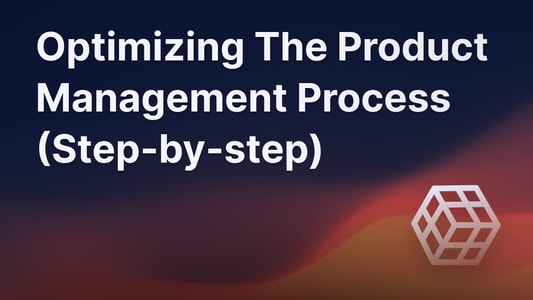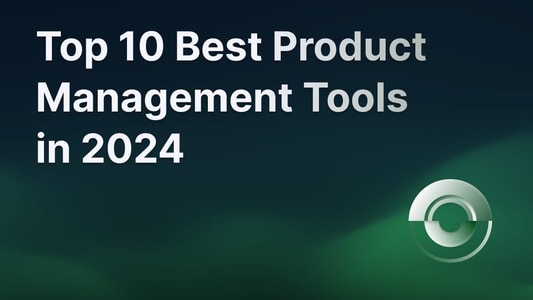Blog Roadmapping12 Public Roadmap Examples for SaaS Companies in 2024
12 Public Roadmap Examples for SaaS Companies in 2024
Public roadmaps are reshaping the SaaS industry - offering a new level of transparency and customer engagement. Dive into our blog to see the best examples, get a step-by-step guide on creating your own, and discover why this approach is revolutionizing customer relationships.

Implementing a public roadmap is slowly becoming the norm for many SaaS companies in 2024.
It's an effortless way to communicate your product vision, manage customer expectations, and keep users in the loop about the progress of ongoing developments.
In this blog post, we will give you an easily digestible overview of 12 real-world public roadmap examples from smaller startups to large enterprises like Microsoft, GitHub, and others.
We will also give you a simple guide about the best way to set up your very own public product roadmap in just a few minutes.
But first, let's quickly cover what *public* roadmaps even are. 👇
What is a public roadmap?
Think of it as a nicely formatted list that shows the future of a company's product development path - basically, all the features or ideas that will be implemented into a product in some timeframe.
Public roadmaps are usually formatted as a simple list view, in a Kanban board layout, or as a timeline view.
Rather than keeping the roadmap private as usual, it's made fully publicly visible to all users, potential customers, and other key stakeholders.
But it's not just a list of upcoming features.
It shows that the company is constantly improving its product and also listening to the users.
The most important part is that users & customers get to see what's coming next and provide invaluable feedback, making them feel part of the journey.
To sum it up, a public roadmap is much much more than a planning tool. It's a bridge between a company and its users, built on transparency and collaboration.
It's how modern companies show they care about their users' needs and manage their expectations.
12 Best Public Roadmap Examples for SaaS companies
Now that we have a great overview of what a public roadmap is and why they are used in the first place, let's dive into real-world examples to give you a good understanding of different approaches.
So, let's hop straight into our hand-picked list of some of the best examples of public roadmaps:
1. Rolla

Created with: Featurebase
Takeaway: Rolla is an amazing example of how to build a transparent company culture with a public product roadmap.
Users see that ideas from other people get implemented and that the company deeply cares about their experience.
The entire lifecycle of features being developed can be followed in a single place, users constantly leave their feedback on all ideas and vote on the most valuable topics.
Each idea also has a timeline to avoid questions like "When is X feature finally coming?".
Rolla roadmap: View live page
2. Atlassian Cloud Roadmap

Created with: Atlassian Migration
Takeaway: The Atlassian Cloud Roadmap showcases how a large enterprise can implement a public roadmap effectively. It's a simple, easy-to-understand list that provides an overview of upcoming features, their expected release dates, and the products they will impact.
Atlassian roadmap: View live page
3. GitHub Public Roadmap

Created with: GithHub
Takeaway: GitHub's public roadmap is an interactive view that reflects their commitment to open-source and community-driven development. It allows users to see upcoming changes, contribute ideas, and track the development status of different features, creating a strong sense of community involvement.
GitHub roadmap: View live page
4. Unity XR

Created with: Productboard
Takeaway: Unity offers a clear and native roadmap on its website. It's a simple view that makes it easy for users to see what's new and what's coming up next. This approach makes it super easy for anyone to understand their future plans.
Unity roadmap: View live page
5. Ahrefs

Create with: Canny
Takeaway: Ahrefs's public roadmap is all about getting users involved.
It's easy to use and lets people vote on what features they want to see next. This way, Ahrefs makes sure they're building what their users really want.
Ahrefs roadmap: View live page
6. Airtable

Created with: Airtable
Takeaway: Airtable uses its platform to showcase its roadmap as well, demonstrating the versatility and power of Airtable. Although it's not entirely optimized for building public roadmaps it's still a great example of a simple roadmap executed well.
Airtable roadmap: View live page
7. Rust

Created with: Nolt
Takeaway: Rust's roadmap is a good example of a straightforward, easy-to-follow plan that's nicely customized to fit their brand. It's also great for gathering and organizing user feedback.
Rust roadmap: View live page
8. Trello

Created with: Trello
Takeaway: Trello uses its own tool to show the roadmap. This approach is like Airtable's – using their product to showcase future plans. It's a smart way to show the capabilities of Trello while keeping users informed.
Trello roadmap: View live page
9. Microsoft 365

Created with: Microsoft 365
Takeaway: Microsoft's public roadmap nicely highlights everything the company is working on and displays when these features can be expected.
Microsoft roadmap: View live page
10. Buffer

Created with: FeatureOS
Takeaway: Buffer also has a clear and interactive roadmap that involves users in the entire planning process.
Buffer roadmap: View live page
11. Hubspot AI Roadmap

Created with: Design software (Figma or sth similar)
Takeaway: Hubspot has a slightly different approach to its public roadmap. It's a nicely designed PDF file with timelines and top-level features, so all stakeholders can be brought into the company's vision. This approach works great for larger enterprises.
Hubspot roadmap: View live page
12. Checkly

Created with: Featurebase
Takeaway: Checkly showcases its public roadmap via a gamified feedback portal to encourage customers to leave feedback. It also supports idea voting, so everything users want the most bubbles to the top.
Checkly roadmap: View live page
Why you should have a public roadmap?
If you aren't yet entirely sure if a public roadmap is something for you, then here's a more detailed overview of how a public roadmap can massively benefit your company.
- Build Customer Trust and Loyalty
When customers see your future plans, they feel more connected and invested in your product. This transparency builds trust, and a trusting customer is a loyal customer. - Capture More Valuable Feedback
No one wants to send feedback into a black hole. Public roadmaps invite feedback and suggestions, turning passive users into active community members. This engagement not only improves your product but also creates a sense of belonging among your users. - Drive Product Development
By showcasing what’s coming next, you align your team’s efforts with customer expectations. It helps in prioritizing features that matter most to your users, ensuring your development is on the right track. - Manage Expectations
A clear roadmap sets realistic expectations about your product’s growth and updates. It helps in managing customer expectations and reduces uncertainty about the product’s future. - Differentiates Your Brand
In crowded markets, a public roadmap can be a huge differentiator. It shows that you value openness and customer feedback - qualities that can set you apart from competitors. - Increase Accountability
Public roadmaps hold you accountable to your plans, ensuring that you’re constantly making progress and updating your product. - Attract Potential Customers and Investors
A well-structured roadmap can be a powerful tool for attracting new customers and investors. It showcases your vision, the direction of your product, and your commitment to growth.
A public product roadmap is more than a feature list with timelines; it's a strategic asset that can create a loyal community, drive product success, and build your brand’s reputation.
Not yet sure? Check out our latest blog that explores the topic "Should your company have a public roadmap?" in more detail.
How to create a public roadmap?
Good news! It's easier than you think.
As you've seen from the 12 examples above, there are many ways to approach this.
Let’s break it down into simple steps:
- Pick Your Style: Reflect on the examples you've seen. Do you like a simple list or something more visual? Your roadmap's style should match your company's personality and be easy for your audience to understand.
- Define Your Goals: What do you want to achieve with your public roadmap? Is it for gathering feedback, setting clear expectations, or showcasing your future plans? Your goals will guide the content and design of your roadmap.
- Collect Insights: Your roadmap should be based on what your users need and want. Use surveys, feedback tools, or direct communication to gather their insights. Remember, this roadmap is as much for them as it is for you.
- Set Priorities: You can’t tackle everything at once. Prioritize features and updates based on user demand and strategic value. This helps in creating a focused and realistic roadmap. For a more in-depth guide about prioritization, check out our guide about planning your product roadmap effectively.
- Keep It Dynamic: Update your roadmap regularly. New challenges constantly arise, and feedback can shift priorities. A dynamic roadmap shows that you’re responsive and adaptable.
- Be Open About Changes: If you need to shift priorities or delay a feature, communicate it openly. Honesty in your roadmap strengthens trust with your users.
- Encourage Interaction: Allow users to comment, give feedback, or even vote on features. This engagement makes them feel valued and involved in your product's journey.
- Choose the Right Tool: There's a variety of tools available for creating roadmaps. Pick one that suits your needs, whether it’s a specialized software or a simple graphic tool like Figma. Consider the tool's ease of use, user interaction capabilities, and integration with your other tools.
If you're looking for a comprehensive tool that handles all of this for you, then check out Featurebase.
It's a simple way to create, publish, and manage a public product roadmap to communicate your vision, engage with your users, and set expectations for your product's development.
Featurebase integrates with all the tools you already use to plug into your workflow and can be fully set up in under 5 minutes.
Create your product roadmap with Featurebase today →
Conclusion
The bottom line is that public roadmaps are more than just planning tools for SaaS companies.
They're a dynamic way to engage with users and build trust.
While the worry of idea theft exists, remember that the most sensitive plans can be kept internal. The positives of transparency, user engagement, and the valuable feedback you gain often outweigh any risks.
So, if you're aiming for transparency and user engagement, a public roadmap could be a crucial step forward. It's not just about sharing your plans—it's about inviting your users to be a part of your product's growth and success.
Create your product roadmap with Featurebase today →
More reading:
- Top 7 Public Roadmap Tools for SaaS Companies in 2024 →
- Should Your Company Have a Public Roadmap? →
- A Simple 6-Step Guide to Plan & Prioritize Your Product Roadmap Effectively →
- The Best Product Roadmap Examples for SaaS Startups →
FAQ
1. What is a Public Product Roadmap?
A public product roadmap is a strategic tool used in SaaS (Software as a Service) to share a company's future plans for their product. It typically includes upcoming features, enhancements, and major updates.
This roadmap is visible to customers, potential users, and stakeholders, offering transparency into the product’s development journey.
2. How Does a Public Roadmap Benefit SaaS Companies and Their Users?
For SaaS companies, a public roadmap is key to building trust and maintaining open communication with their user base.
It allows customers to see what new features or improvements are coming, fostering a sense of involvement and anticipation.
For the company, it’s a way to gather valuable feedback, prioritize development based on user needs, and demonstrate commitment to continuous improvement.
3. What Are the Best Practices for Creating an Effective Public Roadmap for a SaaS Product?
Creating an effective public roadmap involves a few best practices:
- Prioritize Transparency: Be clear about your development goals and timelines.
- Gather User Feedback: Regularly collect and incorporate user insights to ensure the roadmap reflects customer needs.
- Update Regularly: Keep the roadmap current to reflect any changes in priorities or timelines.
- Engage Your Audience: Encourage user interaction with the roadmap through feedback, suggestions, and regular updates.
Implementing these practices helps in crafting a roadmap that's not just informative but also an integral part of your product's community engagement strategy.
The simple feedback tool with feature voting for your customer feedback. Built-in the 🇪🇺.
© 2024 Featurebase. All rights reserved.



